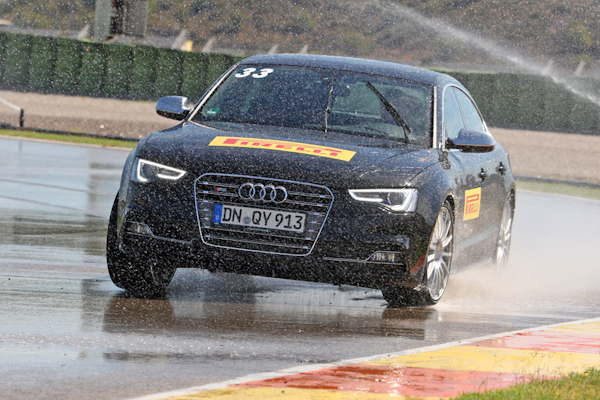![]()
We recently got invited by Pirelli to Valencia to hear about the launch of their latest tyre, the P7 Blue. We spoke to Andrea Acari, a Pirelli tyre testing engineer, to find out just what goes into those black circles they produce.
Computer Testing
Before Pirelli ever even produce a tyre they subject it to a large range of computer simulated tests. These simulations measure how changing the compounds, dimensions and tread patterns of a tyre have an effect on performance.
The computer test are also used to show how the tyre design will cope in terms of grip, fuel economy, degradation and wet handling.
Outdoor Testing
Once the engineers are happy with the computer simulations they take the new tyre into the real world. Every tyre is tested on a multitude of facilities Pirelli have available to them. These include Pirelli’s Milan factory for wet testing, Fiat Group facilities for general testing and the Nardo Circuit for ultra high performance testing. Wet tracks are used to see how tyres perform with slippery surfaces and standing water.
Hot weather testing is carried out in various countries with hot climates, with Sweden and New Zealand used for snow and cold temperature tests.
Noise Testing
All new cars are designed to have minimal road noise, and the tyre chosen is of key importance. Pirelli’s tyres are designed to produce the least noise possible, so multiple tests are run in labs set up to record the noise output on different road conditions.
Fuel Economy Testing
Fuel costs are the biggest concern for UK car owners, and what tyres you buy can have a significant impact on fuel economy. If your tyres are worn, or aren’t inflated to the recommended pressure then your mpg will be worse.
Pirelli use both rolling roads and long distance testing to discover how they can maximise the efficiencies of their tyres.
New Cars
For every new car on sale, the car manufacturers work with tyre companies to develop custom tyres specifically for the car. That means they start working on developing a tyre for a new car way before it’s announced. It typically takes around 1-2 years to develop a tyre for a new car.
Pirelli work closely with all the major car manufacturers, and the tyre is developed while the manufacturer develops their new car, so both take feedback and cooperate throughout the whole process.
Why’s this important? It shows that there isn’t a one-size fits all approach. That a huge amount of work has been put into selecting the perfect fit for each new car, so when you’re replacing the tyres on your car we strongly recommend buying the original tyre it came with.
Motorsport Influences
Pirelli are the tyre supplier to the F1, so it was no coincidence that we were invited to Valencia while the European Grand Prix was in town!
We got VIP access to watch the F1, which gave us a chance to see how the Pirelli engineers liaise with the F1 teams throughout the race. Each F1 team has its own Pirelli engineer assigned to it throughout the season, so that engineer can monitor how the tyres perform and pass the data they collect to the engineering department, so improvements can be made.
Watching the F1 you’d think, due to the number of pit-stops, that it’s impossible to design tyres to cope with the speed, stress and wear that comes during F1. What we didn’t understand, prior to that weekend, was that Pirelli have been told by the FIA that their F1 tyres have to degrade after a set distance covered.
So all those worn out tyres you see on an F1 car are deliberately designed to become less effective after a set number of laps, to increase the strategy involved in planning tyre changes.
So how does this relate to road tyres? The research and development that goes into F1 tyres feeds back from the motorsport division to the road tyres division. It doesn’t get any tougher on tyres than F1, so Pirelli use their findings from motorsport to create the best performing tyres, this knowledge is then applied from their tyres for vans right up to the Pirelli P Zero Corsa, their ultra high performance road tyre.
Check out our guide to the new
UK tyre labels to find out what they mean and discover which is the only AA rated tyre.









